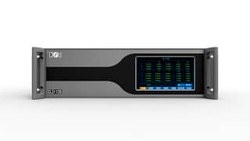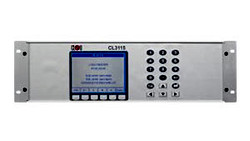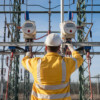The electromagnetic force is a player in the world of power generation and distribution. Alongside gravity, the other fundamental forces include the force that holds atomic nuclei together the weak nuclear force involved in radioactive decay and electromagnetism which governs electricity, magnetism and light. These forces shape how matter behaves and how particles interact in our universe. In physics and engineering, the electromagnetic force holds a position.
Electricity generation is not a topic of interest, in studies but also serves as the foundation of the entire power industry facilitating the interaction between charged particles. This interaction is important for enabling the production, transmission and distribution of electricity that powers our society.
The electromagnetic force plays a role in generating electricity. It is primarily responsible for converting energy into energy, a process commonly observed in power plants. Generators play a role in this conversion process by utilizing induction principles. As a rotor moves within a stator—often driven by steam, water or wind—the magnetic field interacting with windings generates an alternating current (AC). This current is then channelled into the power grid, for transmission over distances.
Different Types of Generators Rely on Electromagnetism to Function Effectively
- Hydroelectric Power Plants
Hydroelectric power plants utilize the kinetic energy of flowing water, typically from a river or reservoir, to generate electricity. As water flows through the plant, it turns large turbines. These turbines are connected to the rotor of a generator. The rotation of the rotor within a magnetic field induces an electric current through electromagnetic induction, thus generating electricity. - Thermal Power Plants
Thermal power plants operate by converting heat energy into electrical energy. This heat is generated by burning fossil fuels (such as coal, natural gas, or oil) or through nuclear reactions. The heat produces steam, which drives turbines connected to a generator. The generator's rotor spins within a magnetic field, creating electricity via electromagnetic induction. - Wind Turbines
Wind turbines capture the kinetic energy of the wind. As the wind blows, it turns the blades of the turbine. These blades are connected to a rotor, which spins inside a generator. The movement of the rotor within the magnetic field induces an electric current, harnessing the power of electromagnetism to produce electricity. - Solar Panels
Solar panels, while not typically generators in the traditional sense, operate on the principles of electromagnetic theory, specifically the photovoltaic effect. This effect occurs when sunlight (photons) strikes the surface of a solar cell, exciting electrons and creating an electric current. This process is more rooted in quantum mechanics than classical electromagnetic induction, but still falls under the electromagnetic theory umbrella.
Electricity Transmission
The journey of electricity from power plants to consumers begins with transmission. High voltage power lines, typically made of materials like copper or aluminium, efficiently transport electricity over distances. The electromagnetic force plays a role by causing electrons to repel and attract each other, leading to the flow of current. The ability of these materials to facilitate electron flow with resistance showcases the properties of the electromagnetic force at the atomic level. But there are certain challenges:
Resistance
Even the highest quality conductors, such as copper and aluminium, exhibit electrical resistance. This resistance causes energy to be lost in the form of heat as electricity flows through the transmission lines. The power loss due to resistance increases with the length of the transmission line and the amount of current flowing through it. This not only reduces the efficiency of electrical transmission but also necessitates additional cooling measures to prevent overheating of the conductors. Engineers continually seek to optimize materials and transmission methods to minimize these losses.
Inductance and Capacitance
Long transmission lines can introduce significant inductance and capacitance effects, which can impact power quality and stability. Inductance occurs due to the magnetic fields generated by the flow of current, while capacitance arises from the electric fields between the conductors and the ground. These effects can cause voltage drops and phase shifts, leading to inefficiencies and potential instability in the power system. To manage these issues, reactive power compensation is often required. This can involve using devices such as capacitors, inductors, and synchronous condensers to balance the inductive and capacitive effects and maintain the desired voltage levels and power quality.
Electricity Distribution
Once electricity reaches substations near communities, it undergoes transformation into voltages, for distribution. The distribution lines that carry electricity to homes and businesses are designed to accommodate voltages using conductors compared to those employed in transmission lines. In this stage, the electromagnetic force ensures a flow of electrons to end users. Here we have:
Transformers
As electricity approaches its final destination, transformers play a central role in lowering the voltage to levels suitable for homes and businesses. In the earlier stages of transmission, electricity is transported at high voltages to minimize losses over long distances. However, these high voltages are not safe for direct use in residential or commercial settings. Step-down transformers reduce the voltage to safer levels, typically ranging from 230 V to 400 V for residential use, depending on the region.
These transformers are strategically placed in substations and along the distribution network to ensure that the voltage is appropriately reduced before reaching the end users.
Distribution Grid Layout
The design of the distribution grid can vary significantly based on infrastructure and local demand. There are primarily two types of distribution grid layouts: radial and network systems.
- Radial Systems
In a radial system, each customer is connected to a single power source. This setup resembles a tree with branches, where each branch represents a distribution line. While this system is simpler and less expensive to implement, it is more susceptible to outages. If a fault occurs on a branch, all customers connected to that branch will lose power until the issue is resolved. - Network Systems
Network or loop systems are more complex but offer greater reliability. In these setups, multiple power sources and interconnected lines create a loop or mesh network. If a fault occurs in one part of the network, power can be rerouted through alternative paths, minimizing the impact on customers. This redundancy makes network systems more resilient to outages and better suited for densely populated areas with high demand.
The choice between these systems depends on various factors, including geographic considerations, population density, and the reliability requirements of the area. Engineers must carefully design and maintain the distribution grid to ensure a stable and reliable supply of electricity to all end users.
Takeaway
Electromagnetic force is not just a force; it is essential in the power industry. Its unparalleled contributions to generating, transmitting, and distributing electricity from the backbone of our modern energy systems. As we advance and deepen our understanding of this force, its applications continue to expand, further supporting our industry and leading us towards a future filled with potential and opportunities.
If you have any inquiries or need further information about our distribution equipment, please do not hesitate to reach out  Contact Usto us. We are here to assist you and welcome your valuable thoughts and comments.
Contact Usto us. We are here to assist you and welcome your valuable thoughts and comments.
Until then, keep shining bright like a solar panel on a sunny day!
Editor's note: This article was originally published in June 2024 and has been updated for comprehensiveness.








All comments are moderated before being published. Inappropriate or off-topic comments may not be approved.